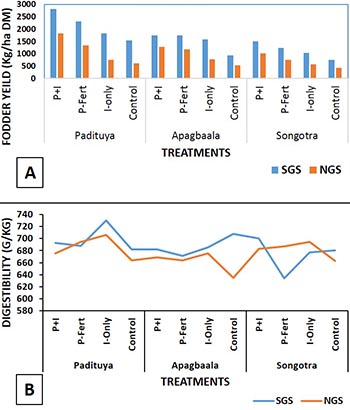Introduction
Cowpea (Vigna unguiculata) is an important crop in the mixed crop livestock systems of northern Ghana since it supplies protein to the human diets, fodder to livestock, and it captures nitrogen into the farming system through biological nitrogen fixation. Cowpea fodder for feeding livestock is traded for cash and animal manure by farmers in northern Ghana. Cowpea grain and fodder yields have been increased through rhizobium inoculation and application of phosphorus fertilizers. However, there is little information about effects of inoculation and phosphorus fertilization on the quality of the fodder.
Objectives
- To evaluate the effect of inoculation and phosphorus fertilizer application on cowpea fodder yield and quality.
- To compare cowpea fodder yield and quality in the Southern Guineas savanna (SGS) and Northern Guinea savanna (NGS) agro-ecological zones (AEZ) of northern Ghana.
Approach
A split-plot design was used with one replicate in a farm in four different communities per agro-ecological zone. The treatments were cowpea varieties (Songotra, Padituya and Apagbaala) as main plot factor. The sub-plot factors were the combinations of inoculation and phosphorus fertilizer (inoculant only, phosphorus fertilizer only, phosphorus and inoculant combined and non-inoculated, non-fertilized control). Fodder yield was estimated after the last pod harvest by cutting the fodder on each plot (30 m2) at ground level and weighing it. Sub-samples were taken for oven-drying for determination of dry weight. Fodder was analysed for in-vitro organic matter digestibility (IVOMD) using Near Infrared Reflectance Spectroscopy (NIRS) and analytical chemistry for calibration. The linear mixed model procedure in GenStat (18th Edition, VSI international Ltd) was used for data analyses. Differences between means were considered to be significant at a confidence interval of P<0.05.
Key results
|
Fodder yields were significantly higher in SGS than NGS. Padituya variety produced the highest average fodder yield (1627 kg/ha) with both inoculation and phosphorus fertilizer application while Songotra produced the least fodder (908 kg/ha) in the control treatment in the two AEZ (Figure 1A). There was also significant interaction between AEZ and phosphorus fertilizer application (P-fert) indicating that P-fert performed differently in the two AEZ. In SGS, there were significant varietal differences for in-vitro organic matter digestibility (IVOMD). In SGS inoculation increased IVOMD while phosphorus fertilizer application had negative effect on IVOMD (Figure 2B). Inoculation in general improved digestibility significantly in the two AEZ with some significant interactions among AEZ, P-fert and inoculation (P<0.007). |

|
Significance
The current study demonstrated that rhizobium inoculation and application of phosphorus fertilizer had influence on cowpea fodder yield and IVOMD differently in the AEZ of northern Ghana. Padituya variety produced the highest fodder with best quality indicators in the two AEZ. Farmers applying the technology of rhizobium inoculation and phosphorus fertilizer application to the right cowpea varieties would not only benefit from yield increases but fodder quality is also enhanced for use in animal production in northern Ghana.
Daniel Brain Akakpo, Wageningen University & Research, The Netherlands (Click here for his 2016 update)
